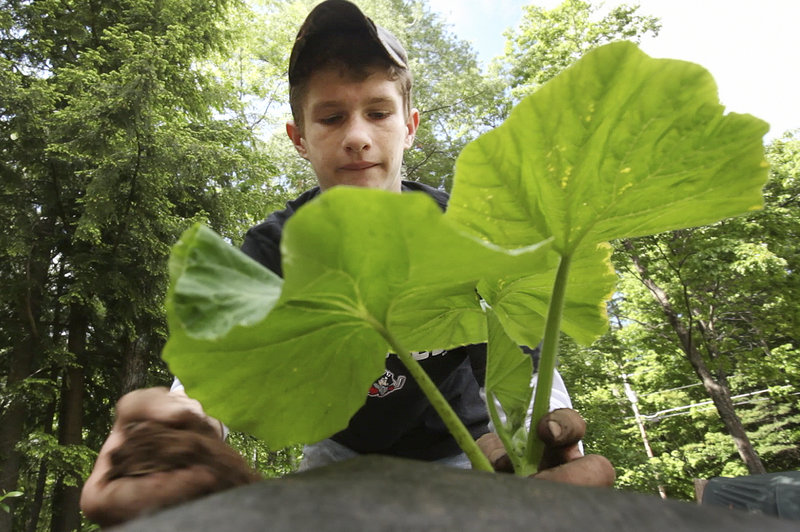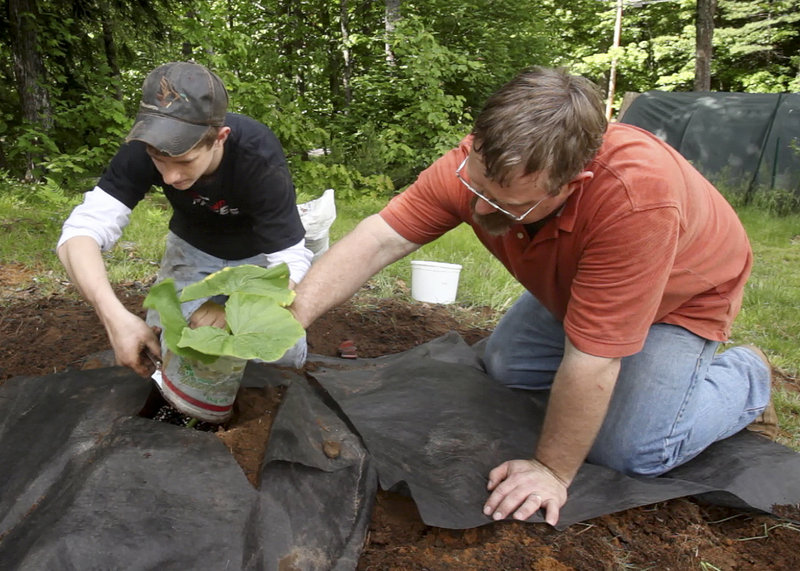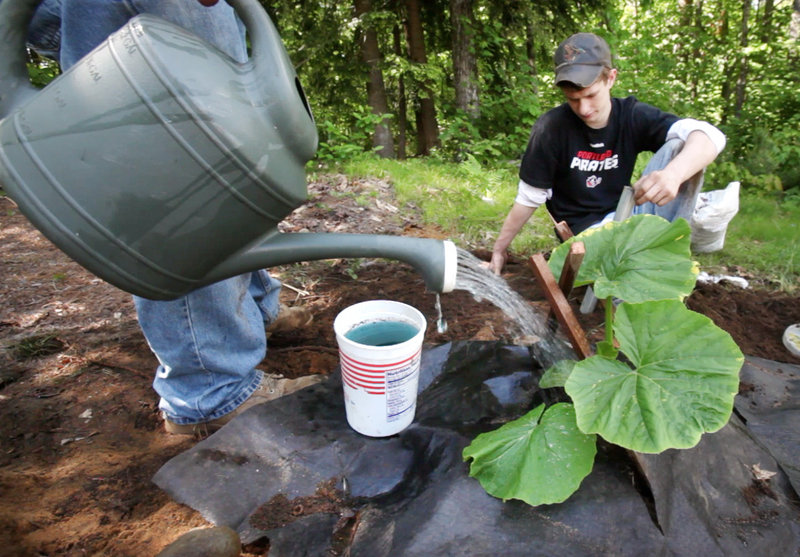EDITOR’S NOTE: This is the first in a series of stories looking at what it takes to grow a giant pumpkin. The stories will follow Lucas Dion, 16, in his first attempt to grow a giant pumpkin at his home in Waterboro.
WATERBORO – There are lots of things to be amazed about when considering giant pumpkins.
After all, they can grow to be 1,000 or more pounds, sometimes gaining 30 pounds a day.
But for Lucas Dion, the thing that amazed him the most — the thing that made him want to spend half a year or so trying to grow one — is that people will pay money for them.
Last year, Lucas’ dad, Jim Dion, grew a 400-pounder on his first attempt. He took it to a pumpkin contest in Sanford and ended up selling it to someone from the Damariscotta Pumpkinfest to be used as a decoration at that annual giant pumpkin party. The selling price was $250, plus a $50 prize won at the Sanford contest.
Lucas, 16, is on the high school wrestling team, and works occasionally at a Dunkin’ Donuts. So $300 for growing a pumpkin seemed like a pretty sweet deal.
“When I heard how much he got, I thought, ‘I could do that,’ ” said Lucas, a junior at Massabesic High School in Waterboro. “I like being outside anyway, doing things outside.”
As he talked, Lucas was in between pumpkin-planting tasks. It was a humid day in late May, and he and his father decided it would be a good day to plant the giant pumpkin seedling.
The seeds had been purchased from another giant pumpkin grower, so they came out of a giant pumpkin — meaning they came from the right stock. He paid about $1 apiece for the 10 or 11 seeds.
“I think they came from a 1,300-pound one,” said Lucas as he spread compost by hand on the spot where he was aiming to plant.
Jim Dion learned the specifics of growing a giant pumpkin last year when he joined the Maine Pumpkin Growers Organization, headed by veteran giant grower Al Berard of Sanford. Dion picked the brains of Berard and others in the club to learn the secrets of giant pumpkin growing.
To hear growers talk — and to read the pages and pages of information on the association’s website, mainepumpkins.com — it’s a delicate and complicated thing to get a pumpkin to grow to its maximum weight and beyond.
For instance, on the day Lucas planted his pumpkin, his father gave him some small stakes to prop up the leaves.
“If the wind gets at the leaves, it can do some damage. You don’t want these leaves blowing around,” Dion told him.
Lucas had begun his giant pumpkin odyssey in early April by planting his seed in a plastic bucket of soil and then creating a “grow room” for it in his bedroom. He put light bulbs as close as possible to the soil for light, and he wrapped an electric blanket around the bucket for warmth. He kept the light and heat on the plant for about 16 hours a day.
He watered and tended the seedling until the day he forgot to lock his bedroom to keep out the family’s dogs, Sophie and Dixie. The dogs tore up the bucket of soil, sending dirt everywhere.
So Lucas can say with a straight face: The dogs ate my giant pumpkin.
Luckily, Jim Dion is growing giant pumpkins again, and he had some “backup” seedlings growing in other parts of the house. So he gave one to Lucas, and that’s the one Lucas ended up planting.
The family’s home is in a wooded area on a dirt road leading toward Lake Arrowhead, in the northern part of Waterboro. Lucas picked a small hill not far from the house, so it will be easy to water but won’t be in full sun.
Eventually, pumpkin vines will cover the hill. Hopefully.
On planting day, Lucas dug a hole and put down both compost and fertilizer designed to give the pumpkin what it needs, including lots of nitrogen.
He spread out cloth material designed to keep weeds out. He made a hole with a teaspoon in the soil to make sure a special liquid fertilizer got to where it was supposed to. Then he watered it.
His dad said the pumpkin plant might need 50 to 70 gallons of water a day, and that he’ll probably help Lucas fix up some sort of overhead watering system.
Other than daily watering, Lucas is planning on checking on the plant daily to see if leaves are bent or broken, to watch where the vines are growing and direct them to ideal spots for growing, and to look for buds and flowers.
Eventually, probably sometime in July, he’ll have to hand-pollinate the plant.
Growing giant pumpkins is too exact a science to leave the pollination to chance, what with bugs and the elements likely to play havoc.
So, following basic recommendations from the Maine Pumpkin Growers Organization, Lucas is planning to watch the flower so he can cover it with something — some growers use plastic bags — the day before it opens.
He’ll need to take the male part of the plant — also covered — peel the petals away, and brush the pollen into the female flower.
Then the fun part begins. The pumpkins begin growing.
Eventually, after watching carefully every day, Lucas will have to determine which pumpkins to cut off the plant, so that all the nutrients and energy go toward creating one giant pumpkin in the fall.
Lucas says he’s interested in the process of learning how and why giants become giants.
But, being a wrestler and a hunter and a teenage boy who could use some spending money, he’s also interested in results.
Like maybe doubling the 400-pounder his father grew last year.
“I think an 800-pounder would be good for a first time,” said Lucas with a smile.
Staff Writer Ray Routhier can be contacted at 791-6454 or at:
rrouthier@pressherald.com
Send questions/comments to the editors.






Success. Please wait for the page to reload. If the page does not reload within 5 seconds, please refresh the page.
Enter your email and password to access comments.
Hi, to comment on stories you must . This profile is in addition to your subscription and website login.
Already have a commenting profile? .
Invalid username/password.
Please check your email to confirm and complete your registration.
Only subscribers are eligible to post comments. Please subscribe or login first for digital access. Here’s why.
Use the form below to reset your password. When you've submitted your account email, we will send an email with a reset code.